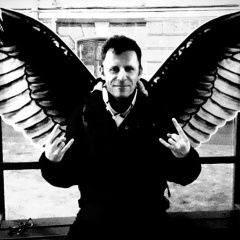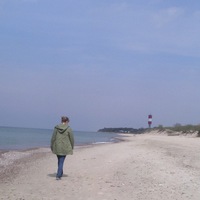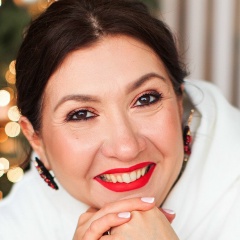Несколько первых отличительных штрихов Калининграда.
Здесь говорят "в России" и "в Россию" относительно остальной страны, исключая себя. Тема окраинных территорий с сильной местной спецификой. То же самое наблюдал в Дагестане.
Здесь человек, заходя в супермаркет, может занять очередь в кассу, а потом уже пойти за покупками. Видел не единожды. Больше такого нигде не встречал.
Прусская тема используется повсеместно от раскраски фургонов, стоящих во дворах угрюмых советских девятин в центре, до колбасок в фаст-фуде. Хотя никаких немцев тут уже давно нет. И всё это довольно причудливо смотрится на фоне советской топонимики.
Люди довольно расслабленные. Никуда не спешат. Многие вечером фланируют по городу с пивом.
Для города с неполным полумиллионом населения культурная жизнь по российским меркам супернасыщенная. При этом сюда идёт постоянный приток населения из разных городов России. В том числе, из Москвы. Влиться в город, где все, по большому счёту приехавшие в одном-двух поколениях, похоже, несложно. А возможность дёшево путешествовать по Европе и миру - один из бонусов, притягивающих сюда новых жителей.
Все местные, с кем я разговаривал, очень любят свой город.
То, как сплелись Калининград и Кёнигсберг, выглядит абсолютно уникально. Нет ничего общего с другими городами Европы, разрушенными войной, по какому бы они пути не начали строить жизнь дальше. Тихие очень зелёные суперуютные уголки перемежаются с очень шумными трассами, которые сложно перейти пешеходу. Прусское архитектурное наследие не вплетено в нынешний контекст и не задавлено Калининградом 1970-х. Оно будто живёт перпендикулярной ему жизнью. Но это отдельная тема.
Здесь говорят "в России" и "в Россию" относительно остальной страны, исключая себя. Тема окраинных территорий с сильной местной спецификой. То же самое наблюдал в Дагестане.
Здесь человек, заходя в супермаркет, может занять очередь в кассу, а потом уже пойти за покупками. Видел не единожды. Больше такого нигде не встречал.
Прусская тема используется повсеместно от раскраски фургонов, стоящих во дворах угрюмых советских девятин в центре, до колбасок в фаст-фуде. Хотя никаких немцев тут уже давно нет. И всё это довольно причудливо смотрится на фоне советской топонимики.
Люди довольно расслабленные. Никуда не спешат. Многие вечером фланируют по городу с пивом.
Для города с неполным полумиллионом населения культурная жизнь по российским меркам супернасыщенная. При этом сюда идёт постоянный приток населения из разных городов России. В том числе, из Москвы. Влиться в город, где все, по большому счёту приехавшие в одном-двух поколениях, похоже, несложно. А возможность дёшево путешествовать по Европе и миру - один из бонусов, притягивающих сюда новых жителей.
Все местные, с кем я разговаривал, очень любят свой город.
То, как сплелись Калининград и Кёнигсберг, выглядит абсолютно уникально. Нет ничего общего с другими городами Европы, разрушенными войной, по какому бы они пути не начали строить жизнь дальше. Тихие очень зелёные суперуютные уголки перемежаются с очень шумными трассами, которые сложно перейти пешеходу. Прусское архитектурное наследие не вплетено в нынешний контекст и не задавлено Калининградом 1970-х. Оно будто живёт перпендикулярной ему жизнью. Но это отдельная тема.
A few first distinctive touches of Kaliningrad.
Here they say "in Russia" and "to Russia" in relation to the rest of the country, excluding themselves. Suburban area theme with strong local identity. I observed the same thing in Dagestan.
Here, a person entering a supermarket can take a queue at the checkout and then go shopping. I saw it more than once. I have never seen anything like this anywhere else.
The Prussian theme is used everywhere from the coloring of the vans in the courtyards of the gloomy Soviet deviats in the center to sausages in fast food. Although no Germans have been here for a long time. And all this looks rather bizarre against the background of Soviet place names.
People are pretty relaxed. They are in no hurry. Many flock around the city with beer in the evening.
For a city with less than half a million population, cultural life is super-saturated by Russian standards. At the same time, there is a constant influx of population from different cities of Russia. Including from Moscow. It seems that it is not difficult to join the city, where everyone who came in one or two generations, by and large. And the ability to travel cheaply across Europe and the world is one of the bonuses that attract new residents here.
All the locals I spoke to love their city very much.
The way Kaliningrad and Koenigsberg intertwined looks absolutely unique. There is nothing in common with other cities in Europe, destroyed by the war, no matter which way they began to build life further. Quiet, very green super cozy corners interspersed with very noisy roads that are difficult for pedestrians to cross. Prussian architectural heritage is not woven into the current context and is not crushed by Kaliningrad in the 1970s. It seems to live a life perpendicular to it. But this is a separate topic.
Here they say "in Russia" and "to Russia" in relation to the rest of the country, excluding themselves. Suburban area theme with strong local identity. I observed the same thing in Dagestan.
Here, a person entering a supermarket can take a queue at the checkout and then go shopping. I saw it more than once. I have never seen anything like this anywhere else.
The Prussian theme is used everywhere from the coloring of the vans in the courtyards of the gloomy Soviet deviats in the center to sausages in fast food. Although no Germans have been here for a long time. And all this looks rather bizarre against the background of Soviet place names.
People are pretty relaxed. They are in no hurry. Many flock around the city with beer in the evening.
For a city with less than half a million population, cultural life is super-saturated by Russian standards. At the same time, there is a constant influx of population from different cities of Russia. Including from Moscow. It seems that it is not difficult to join the city, where everyone who came in one or two generations, by and large. And the ability to travel cheaply across Europe and the world is one of the bonuses that attract new residents here.
All the locals I spoke to love their city very much.
The way Kaliningrad and Koenigsberg intertwined looks absolutely unique. There is nothing in common with other cities in Europe, destroyed by the war, no matter which way they began to build life further. Quiet, very green super cozy corners interspersed with very noisy roads that are difficult for pedestrians to cross. Prussian architectural heritage is not woven into the current context and is not crushed by Kaliningrad in the 1970s. It seems to live a life perpendicular to it. But this is a separate topic.

У записи 62 лайков,
2 репостов,
1109 просмотров.
2 репостов,
1109 просмотров.
Эту запись оставил(а) на своей стене Андрей Кочетков






































































